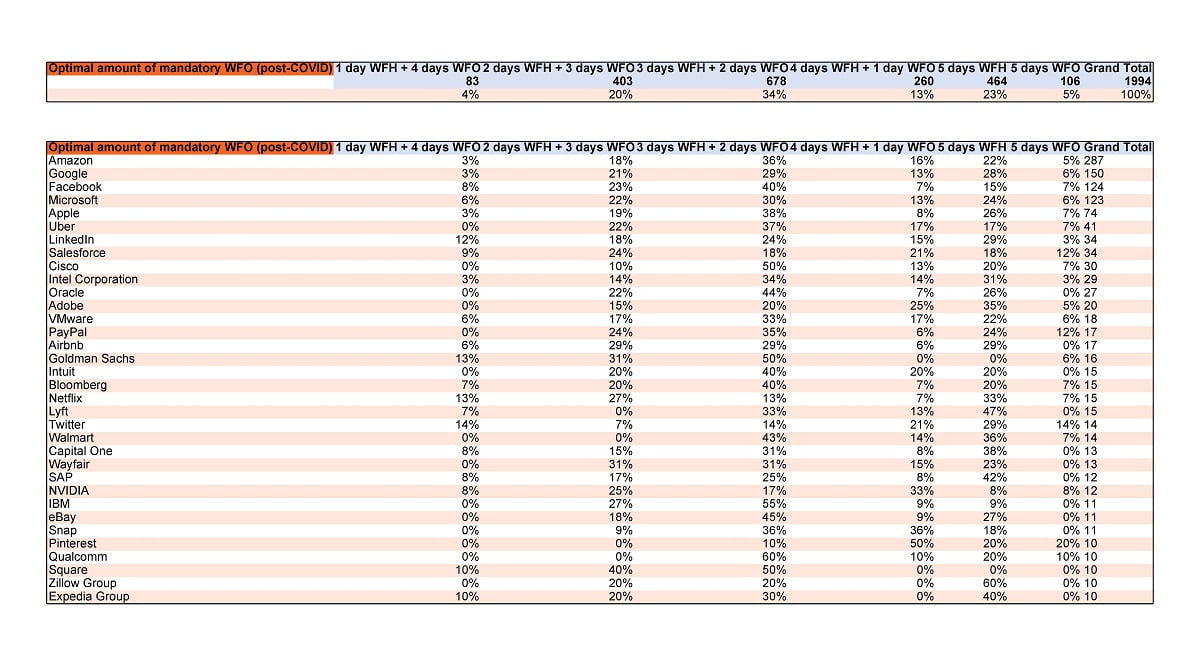The days of physically reporting to an office every day of the workweek are not likely to resume once the COVID-19 pandemic is over. Professionals have become accustomed to working remotely, and splitting time between the office and home is expected to become the new normal.
Q4 2020 hedge fund letters, conferences and more
A Google professional asked the Blind platform, what the "Optimal amount of mandatory WFO (post-COVID)" would be.
Here are the key learnings from nearly 2,000 professionals:
- 43% of professionals think the ideal hybrid model is "3 days WFH + 2 days WFO"
-
- Most Facebook employees, 40%, agree that the ideal hybrid model is "3 days WFH + 2 days WFO"
- 23% of professionals think the ideal hybrid model is "5 days WFH"
- 20% of professionals think the ideal hybrid model is "2 days WFH + 3 days WFO"
- 13% of professionals think the ideal hybrid model is "4 days WFH + 1 day WFO"
- 5% of professionals think the ideal hybrid model is "5 days WFO"
- 20% of Pinterest professionals think the ideal hybrid model is "5 days WFO"
- 4% of professionals think the ideal hybrid model is "1 day WFH + 4 days WFO"
See a breakdown of company preferences here.
The Benefits Of Working From Home
A professional at Amazon commented, "I suspect the companies who can manage it will offer 2/3 hybrid for many years to come. Even when (?) covid is no longer a life-threatening reality, I think companies have seen the benefits as well as the cost of remote work. The hybrid model will be sought to balance these advantages against the advantages of in-office time."
A Microsoft professional shared, "Working from home this past year enabled me to work through personal grief and also use the commute time to get back into the exercise program that grief derailed. I've lost 20 pounds on the scale, and I've gained 12 pounds of muscle (I'm a woman), and I'm now back to the lithe size I was in high school and before the unthinkable happened. I recognize myself again and remember just how strong I am outside and in.
Working from home has so many plusses for me. But a big one is that my workout program is 6 days a week, so I would like to continue using my commute time effectively all week. That's critical me time.
Yes, meetings start earlier and end later now, but I have put my foot down and am protecting my time, and I have seen the meeting hours scaled back recently due to universal fatigue. Plus, once enough people go back into the office -- and we are also able to go out and have social lives again-- the calendar will right itself."
A professional at Paypal commented, "I would rather prefer one week a month for the team to be in office together.... spread out different teams for different weeks. And one more week for cross team whiteboarding/brainstorming activities where only invited folks show up in person. Allow RV parking or make sleep pods available for folks who don't want to drive back during that "office" week (allows one to live farther away from the crowded Bay Area). Solves the expensive real estate problem for both employee and the employer. Less travel solves traffic congestion."
Although the pandemic has intensified the discussion around the pros and cons of working from home and working without an office means, it is safe to conclude that the best alternative is not to opt between one or the other but to give employees the option.






